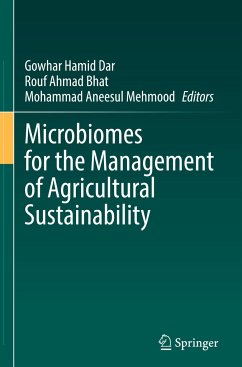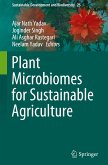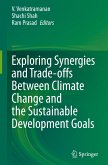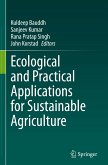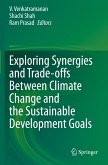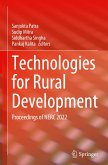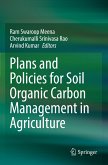Microbiomes for the Management of Agricultural Sustainability
Herausgegeben:Dar, Gowhar Hamid; Bhat, Rouf Ahmad; Mehmood, Mohammad Aneesul
Microbiomes for the Management of Agricultural Sustainability
Herausgegeben:Dar, Gowhar Hamid; Bhat, Rouf Ahmad; Mehmood, Mohammad Aneesul
- Gebundenes Buch
- Merkliste
- Auf die Merkliste
- Bewerten Bewerten
- Teilen
- Produkt teilen
- Produkterinnerung
- Produkterinnerung
This volume discusses innovative advancements in soil and crop microbiome technology and methods to support agricultural sustainability and reduce soil degradation. As climate change impacts agricultural productivity and soil health in impacted regions throughout the world, potential alternatives to find balance between soil health and crop yield are increasingly needed. Therefore, this book provides a timely, global perspective with a collection of expert authors to address how microbiomes can be used to achieve agricultural sustainability in threatened and degraded areas, while also covering…mehr
Andere Kunden interessierten sich auch für
![Plant Microbiomes for Sustainable Agriculture Plant Microbiomes for Sustainable Agriculture]() Plant Microbiomes for Sustainable Agriculture134,99 €
Plant Microbiomes for Sustainable Agriculture134,99 €![Exploring Synergies and Trade-offs between Climate Change and the Sustainable Development Goals Exploring Synergies and Trade-offs between Climate Change and the Sustainable Development Goals]() Exploring Synergies and Trade-offs between Climate Change and the Sustainable Development Goals112,99 €
Exploring Synergies and Trade-offs between Climate Change and the Sustainable Development Goals112,99 €![Ecological and Practical Applications for Sustainable Agriculture Ecological and Practical Applications for Sustainable Agriculture]() Ecological and Practical Applications for Sustainable Agriculture186,99 €
Ecological and Practical Applications for Sustainable Agriculture186,99 €![Exploring Synergies and Trade-offs between Climate Change and the Sustainable Development Goals Exploring Synergies and Trade-offs between Climate Change and the Sustainable Development Goals]() Exploring Synergies and Trade-offs between Climate Change and the Sustainable Development Goals112,99 €
Exploring Synergies and Trade-offs between Climate Change and the Sustainable Development Goals112,99 €![Ecological and Practical Applications for Sustainable Agriculture Ecological and Practical Applications for Sustainable Agriculture]() Ecological and Practical Applications for Sustainable Agriculture186,99 €
Ecological and Practical Applications for Sustainable Agriculture186,99 €![Technologies for Rural Development Technologies for Rural Development]() Technologies for Rural Development149,99 €
Technologies for Rural Development149,99 €![Plans and Policies for Soil Organic Carbon Management in Agriculture Plans and Policies for Soil Organic Carbon Management in Agriculture]() Plans and Policies for Soil Organic Carbon Management in Agriculture149,99 €
Plans and Policies for Soil Organic Carbon Management in Agriculture149,99 €-
-
-
This volume discusses innovative advancements in soil and crop microbiome technology and methods to support agricultural sustainability and reduce soil degradation. As climate change impacts agricultural productivity and soil health in impacted regions throughout the world, potential alternatives to find balance between soil health and crop yield are increasingly needed. Therefore, this book provides a timely, global perspective with a collection of expert authors to address how microbiomes can be used to achieve agricultural sustainability in threatened and degraded areas, while also covering related matters including soil health, pest management, waste disposal, environmental contamination, biofertilizer production, composting, and microbial engineering. The book is meant to serve as a reference for agriculturalists, environmentalists, graduate and post-graduate students, researchers, and professors of sustainability and agricultural management.
Produktdetails
- Produktdetails
- Verlag: Springer / Springer Nature Switzerland / Springer, Berlin
- Artikelnr. des Verlages: 978-3-031-32966-1
- 2023
- Seitenzahl: 344
- Erscheinungstermin: 25. Juli 2023
- Englisch
- Abmessung: 241mm x 160mm x 23mm
- Gewicht: 744g
- ISBN-13: 9783031329661
- ISBN-10: 303132966X
- Artikelnr.: 67759780
- Herstellerkennzeichnung Die Herstellerinformationen sind derzeit nicht verfügbar.
- Verlag: Springer / Springer Nature Switzerland / Springer, Berlin
- Artikelnr. des Verlages: 978-3-031-32966-1
- 2023
- Seitenzahl: 344
- Erscheinungstermin: 25. Juli 2023
- Englisch
- Abmessung: 241mm x 160mm x 23mm
- Gewicht: 744g
- ISBN-13: 9783031329661
- ISBN-10: 303132966X
- Artikelnr.: 67759780
- Herstellerkennzeichnung Die Herstellerinformationen sind derzeit nicht verfügbar.
Gowhar Hamid Dar PhD, is currently working as an Assistant Professor in Environmental Science, Sri Pratap College, Cluster University Srinagar, Department of Higher Education (J&K). He has a PhD in Environmental Science with specialization in Environmental Microbiology (Fish Microbiology, Fish Pathology, Industrial Microbiology, Taxonomy and Limnology). He has been teaching postgraduate and graduate students for the past many years at Post-graduate Department of Environmental Science, Sri Pratap College, Cluster University Srinagar. He has more than 70 research articles (h -index 15; i-index 20; total citation >950) in international and national journals of repute and also has more than 20 books with international publishers (Springer, Elsevier, CRC Press Taylor and Francis, Apple Academic Press, John Wiley, IGI Global) to his credit. Moreover, he is supervising a number of students for the completion of degrees (PhD/Masters). He has beenworking on the isolation, identification and characterization of microbes for a decade to understand their utility for humans particularly in agriculture and industrial sectors. His research is based to understand the pathogenic behaviour of bacteria and to particularly understand the impact of pollution on development of diseases in fish fauna in Kashmir Himalaya. He has received many awards and appreciations for his services towards the science and development. Besides, he also acts as a member of various research and academic committees. Further, Dr. Dar is Principal Investigator and Co-Principal Investigator for different R&D projects sanctioned by Govt. of India and Govt. of Jammu and Kashmir. Rouf Ahmad Bhat PhD, has pursued his doctorate at Sher-e-Kashmir University of Agricultural Sciences and Technology Kashmir (Division of Environmental Sciences) and presently working in the Department of School Education, Government of Jammu and Kashmir. Dr. Bhat has been teaching graduate and postgraduate students of environmental sciences for the past 3 years. He is an author of more than 55 research articles (h-index 28; I index 40; total citation 2050) and 45 book chapters, and has published more than 40 books with international publishers (Springer, Elsevier, CRC Press Taylor and Francis, Apple Academic Press, John Wiley, IGI Global . He has his specialization in Limnology, Toxicology, Phytochemistry and Phytoremediation. Dr. Bhat has presented and participated in numerous state, national, and international conferences, seminars, workshops, and symposium. Besides, he has worked as an associate environmental expert in World Bank-funded Flood Recovery Project and also the environmental support staff in the Asian Development Bank (ADB)-funded development projects. He has received many awards, appreciations, and recognition for his services to the science of water testing, air and noise analysis. He has served as an editorial board member and a reviewer of reputedinternational journals. Dr. Bhat is still writing and experimenting with diverse capacities of plants for use in aquatic pollution remediation. Mohammad Aneesul Mehmood (PhD) has his specialisation in Limnology and Environmental Toxicology. He completed his doctorate with meritorious certificate from the Division of Environmental Science, Sher-e-Kashmir University of Agricultural Sciences and Technology of Kashmir, Shalimar campus, Srinagar, J&K. He was awarded with Dr. Mumtaz Ahmad Khan Gold Medal and Shri Bhushan Memorial Gold Medal for his outstanding performance during his master's programme both in curricular and extra-curricular activities. He was awarded with Late Sri N. Rama Rao Endowment (Highest Cash Prize) at 48th annual convocation of Bangalore University 2013 for securing top position in his master's programme. He has qualified various state level and National Level Competitive Examinations in the subject of Environmental Science like UGC NET, JK-SET and ASRB-NET etc. He was also awarded with INSPIRE Merit Fellowship (JRF & SRF) by the Department of Science and Technology, GoI, during his doctoral programme. He was also awarded with Young Scientist Award at International Conference on Multidisciplinary Research and Latest Innovation 2018. He has also obtained his post graduate diploma in disaster management with distinction grade from Indira Gandhi national Open University, New Delhi in 2014. He has-been teaching graduate and postgraduate students of Environmental Science from past many years. He has been supervising various students for their Masters projects within and outside Jammu & Kashmir in various colleges and universities. Furthermore, he has a number of publications in national and international journals of repute and a number of books with national and international publishers.
Chapter 1. Integrated Approaches to Agri-Nanotechnology: Applications, Challenges and Future Perspectives.- Chapter 2. Microbiota in sustainable degradation of organic waste and its utilization in agricultural industry.- Chapter 3. Microbial degradation of toxic Agri wastes.- Chapter 4. Introduction of Biofertilizers in Agriculture with Emphasis on Nitrogen Fixers and Phosphate Solubilizers.- Chapter 5. Biofertilizers and biopesticides: approaches towards sustainable development.- Chapter 6. Credibility of biofertilizers towards restoration of fertility phenomenon in degraded soil environs.- Chapter 7. Macrophytes as biofertilizer for Agriculture: Concept and Applications.- Chapter 8. Potential role of biofertilizers in fruit crops.- Chapter 9. Microbial Biofertilizers: An Approach to Sustainable Agriculture.- Chapter 10. Actinomycetes as biofertilizers for Sustainable agriculture.- Chapter 11. Innovations in Biotechnology: Boon for Agriculture and Soil fertility.- Chapter 12. Microbiomes in Climate Smart Agriculture and sustainability.- Chapter 13. Genetic engineering towards improvement of phosphorus agricultural utilization.- Chapter 14. Pseudomonas as backbone for environmental health.- Chapter 15. Cyanobacteria as sustainable microbe for agricultural industries.- Chapter 16. Functional Diversity of Endophytic Microbiota in Crop Management of Cucumis sativus L.- Chapter 17. NANOSCIENCE IN AGRICULTURAL STEADINESS.- Chapter 18. Carbon and Silver Nanoparticles for Applications in Agriculture.
Chapter 1. Integrated Approaches to Agri-Nanotechnology: Applications, Challenges and Future Perspectives.- Chapter 2. Microbiota in sustainable degradation of organic waste and its utilization in agricultural industry.- Chapter 3. Microbial degradation of toxic Agri wastes.- Chapter 4. Introduction of Biofertilizers in Agriculture with Emphasis on Nitrogen Fixers and Phosphate Solubilizers.- Chapter 5. Biofertilizers and biopesticides: approaches towards sustainable development.- Chapter 6. Credibility of biofertilizers towards restoration of fertility phenomenon in degraded soil environs.- Chapter 7. Macrophytes as biofertilizer for Agriculture: Concept and Applications.- Chapter 8. Potential role of biofertilizers in fruit crops.- Chapter 9. Microbial Biofertilizers: An Approach to Sustainable Agriculture.- Chapter 10. Actinomycetes as biofertilizers for Sustainable agriculture.- Chapter 11. Innovations in Biotechnology: Boon for Agriculture and Soil fertility.- Chapter 12. Microbiomes in Climate Smart Agriculture and sustainability.- Chapter 13. Genetic engineering towards improvement of phosphorus agricultural utilization.- Chapter 14. Pseudomonas as backbone for environmental health.- Chapter 15. Cyanobacteria as sustainable microbe for agricultural industries.- Chapter 16. Functional Diversity of Endophytic Microbiota in Crop Management of Cucumis sativus L.- Chapter 17. NANOSCIENCE IN AGRICULTURAL STEADINESS.- Chapter 18. Carbon and Silver Nanoparticles for Applications in Agriculture.

